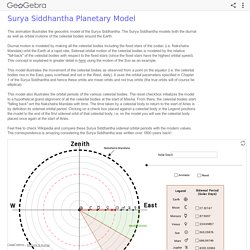

Cubes.io: 3d cellular automata. Wikiverse: a galactic reimagining of Wikipedia. Universcale. BrainPOP. Euclid: The Game - Tutorial. Click that ’hood! OneZoom Tree of Life Explorer. Number Gossip. In Space We Trust — the art-project about space exploration. Diffen - Compare Anything. Diffen. Discern. Decide. Moongiant - Current moon phases & moon position. Jheronimus Bosch - the Garden of Earthly Delights. Cookies op de website van de NTR.
Geef uw toestemming! Wij plaatsen Functionele cookies, om deze website naar behoren te laten functioneren en Analytische cookies waarmee wij het gebruik van de website kunnen meten. Deze cookies gebruiken geen persoonsgegevens Hieronder kan je aangeven welke andere soorten cookies je wilt accepteren: Meer uitleg over cookiesMinder uitleg over cookies Waarom cookies? De Nederlandse Publieke Omroep plaatst specifieke cookies om het gebruiksgemak voor bezoekers te vergroten. Hiermee kunnen we de bezochte website zo gebruiksvriendelijke en interessant mogelijk maken voor de bezoeker. Functionele cookies Cookies die er voor zorgen dat deze website naar behoren functioneert De websites van de NTR gebruiken cookies om er voor te zorgen dat onze websites naar behoren werken.
Webstatistieken Cookies waarmee wij het gebruik van de website kunnen meten. Het is onderdeel van de (wettelijke) taak van de Nederlandse Publieke Omroep om te rapporteren over onze prestaties. McCullough Effect. Read this first: If you follow the instructions below, you will change your brain for a prolonged time (up to month), in addition to simply remembering this.

Proceed only if this is ok with you. What to see Initially you will see a simple 2×2 checkerboard consisting of horizontally and vertically striped squares. And the stripes will be black-white, no colour. Fine so far. What to do Select the radio button “Adapt”. When you feel you have adapted sufficiently long (no need to pay attention to colours or stripes, just follow the fixation letters), switch back to the radio button “Test” (or press Reset). If you rotate your head or the screen, you can observe that the colours will attach to the other set of lines.
Comments Aftereffects are commonly observed in your daily life, e.g. after looking into the sun (very briefly!). Discover The Story Of Motoring: An Interactive History. Fluid Simulator. Check out my blog!

E-mail: kotsoft@gmail.com Fluid Instructions: You can drag the fluid around with your mouse and adjust the sliders at the top to change the properties of the fluid in real-time. Please check out this video if you're having trouble figuring out what the sliders do. It requires Java to run. Check out my newest app: Grantophone! More cool demos! Please enable JavaScript to view the <a href=" powered by Disqus. About This is my implementation of the Material Point Method. For interpolation, I use the quadratic B-spline presented here: Analysis and Reduction of Quadrature Errors in the Material Point Method. Instead of integrating the density over time (which is what most of the MPM papers do), I do a density summation every frame. Material Parameters Some of these parameters are hard to explain in one or two sentences (and a couple I made up) so I'll also link you to their corresponding Wikipedia pages.
Population.io. The Planetarium. Ice and sky. Histography - Timeline of History. The Standard Model of Particle Physics. Earth Polychromatic Camera. The Timescale of Life. PHYSICS MAP. 100,000 Stars. Imagining the Tenth Dimension - A Book by Rob Bryanton. WIKISKY.ORG. The Scale of the Universe – Scale of the Universe.
Surya Siddhantha Planetary Model. This animation illustrates the geocetric model of the Surya Siddhantha.

The Surya Siddhantha models both the diurnal as well as orbital motions of the celestial bodies around the Earth. Diurnal motion is modeled by making all the celestial bodies including the fixed stars of the zodiac (i.e. Nakshatra Mandala) orbit the Earth at a rapid rate. If the Moon Were Only 1 Pixel - A tediously accurate map of the solar system. Mercury Venus Earth You Are Here Moon Mars Jupiter Io Europa Ganymede Callisto. Planet Hunters. Animagraffs - Animated infographics by Jacob O'Neal.
SpaceBook® Frontier of Physics: Interactive Map. “Ever since the dawn of civilization,” Stephen Hawking wrote in his international bestseller A Brief History of Time, “people have not been content to see events as unconnected and inexplicable.

They have craved an understanding of the underlying order in the world.” In the quest for a unified, coherent description of all of nature — a “theory of everything” — physicists have unearthed the taproots linking ever more disparate phenomena. With the law of universal gravitation, Isaac Newton wedded the fall of an apple to the orbits of the planets. Albert Einstein, in his theory of relativity, wove space and time into a single fabric, and showed how apples and planets fall along the fabric’s curves. And today, all known elementary particles plug neatly into a mathematical structure called the Standard Model.